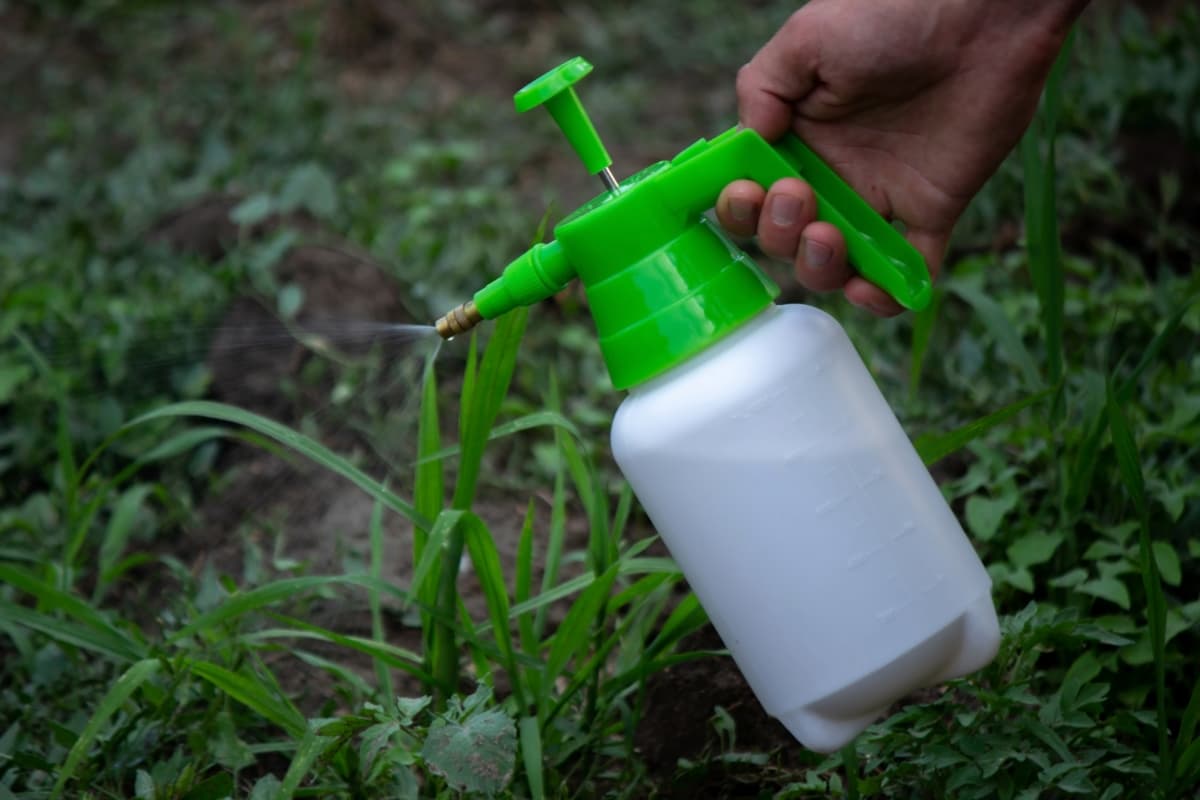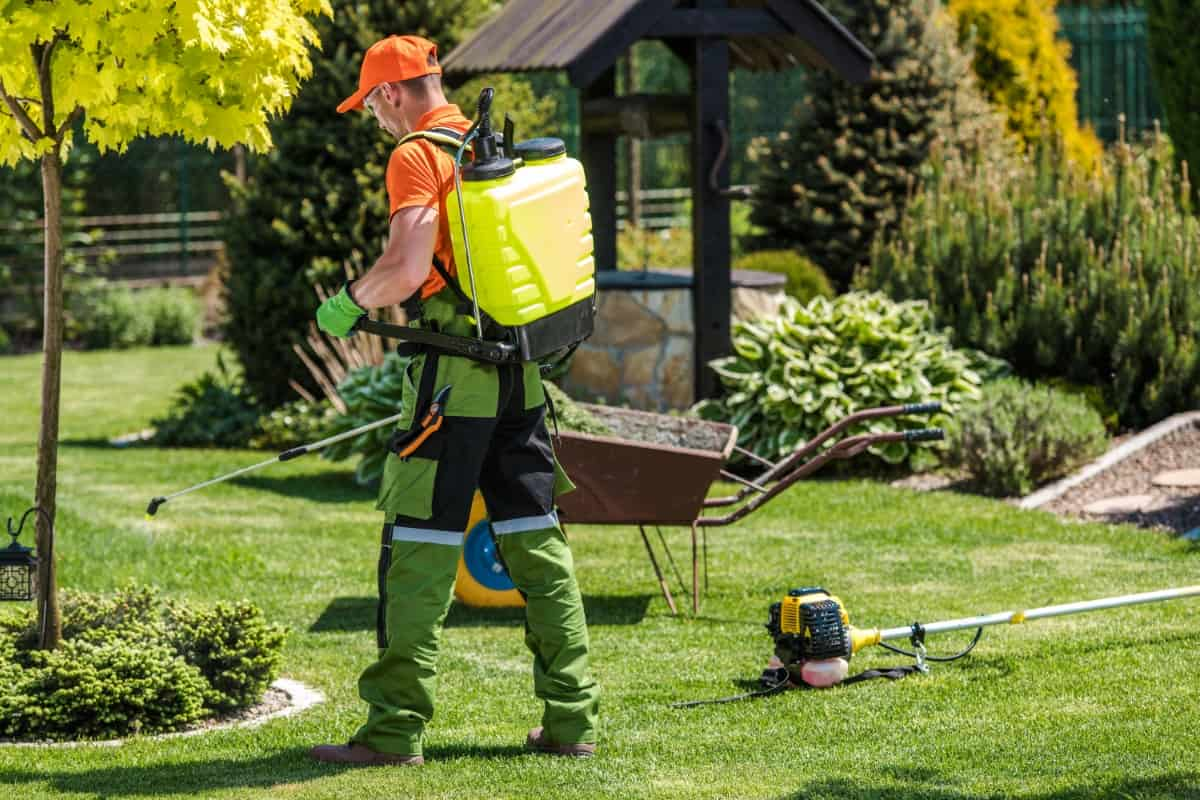Maintaining a lush, green lawn needs more than just regular watering and mowing; it involves keeping pesky insects and pests at bay. Lawn pests can wreak havoc on your carefully nurtured grass, causing brown patches, yellowing, and an overall decline in the health of your lawn. While commercial pesticides are readily available, some homeowners prefer a more natural and DIY approach to pest control. In this guide, we’ll explore how to get rid of lawn pests using homemade sprays. These DIY solutions are not only effective but also eco-friendly, minimizing the impact on the environment and your family.

How to Get Rid of Lawn Pests with Homemade Sprays
Common Lawn Pests and Their Damage
- Common lawn pests include grubs, which are the larvae of beetles, causing the grass to wither and brown as they feed on roots.
- Chinch bugs are small insects that extract sap from grass, leading to yellow patches.
- Armyworms, moth larvae, devour grass blades, causing irregular brown spots.
- White grubs, the larvae of Japanese beetles, feed on grass roots, resulting in weakened turf.
- Sod webworms spin silken webs while feeding on grass, causing visible damage.
- Additionally, nematodes and microscopic worms can harm grassroots.
Identify Signs of Lawn Pest Infestation
Signs of a lawn pest infestation include yellowing or browning patches of grass, which may indicate grub or chinch bug activity as they feed on roots or extract sap. Irregularly shaped brown spots can signal armyworm or sod webworm infestations, as these larvae consume grass blades. Surface tunnels created by moles or voles while searching for insects underground are another indication.
Japanese beetle larvae, or white grubs, cause grass to lift easily, resembling a loose carpet. Weakened or dying grass that easily pulls up from the soil may suggest nematode damage. Vigilant observation, noting changes in grass color and texture, along with physical inspection, helps identify the specific pest and facilitates targeted control measures.
Natural Homemade Sprays for Controlling Lawn Pests
Create natural homemade sprays to control lawn pests by combining ingredients like garlic, neem oil, and dish soap. For a general insect repellent, mix neem oil (1 tablespoon), garlic juice (1 tablespoon), and a few drops of dish soap in 4 liters of water. This blend deters various pests.
In case you missed it: DIY Citrus Oil Spray for Houseplant Pests: Homemade Natural and Organic Bug Control Recipe

To target specific insects like aphids, mix vegetable oil (1 cup) with mild liquid soap (one tablespoon) and dilute in a gallon of water. For a natural grub control spray, blend two tablespoons of liquid dish soap with 4 liters of water. Apply these solutions with a sprayer, covering affected areas, and reapply as needed. Regular use can help manage lawn pests without resorting to synthetic chemicals.
Essential Oils and Their Role in DIY Pest Control Sprays for Lawns
Essential oils play a key role in DIY pest control sprays for lawns due to their natural insect-repelling properties. Oils like peppermint, citronella, eucalyptus, and tea tree are effective against various pests. Create a homemade spray by mixing a few drops of any one of these essential oils with water and a small amount of dish soap to enhance adhesion.
This concoction acts as a potent and eco-friendly repellent for pests such as mosquitoes, ants, and fleas. Essential oils not only offer a pleasant fragrance but also serve as a safer alternative to synthetic pesticides, promoting a healthier and more sustainable approach to lawn care.
Use Organic Ingredients to Make Pest Control Solutions for Lawns
Craft organic pest control solutions for lawns using common kitchen ingredients. Combine garlic cloves, neem oil, and cayenne pepper for a versatile insect repellent. Blend onion, soap, and water to deter pests like aphids. Mix vegetable oil, mild soap, and water to create a natural insecticide for soft-bodied pests.
Employ diatomaceous earth to control crawling insects. For a fungal deterrent, use a mixture of baking soda and water. Additionally, introduce beneficial nematodes to the soil for organic grub control. These homemade remedies are eco-friendly, promoting a chemical-free approach to pest management that is safe for the environment, pets, and beneficial insects.
Application Techniques for Homemade Lawn Pest Sprays for Lawns
Apply homemade lawn pest sprays effectively by using proper techniques. For a general insect repellent, evenly spray the solution over the entire lawn, focusing on affected areas—target specific pests by directly spraying them with a more concentrated mixture. Apply early in the morning or late in the day to avoid sunburn on plants. Ensure thorough coverage by using a pump sprayer or a hose-end sprayer with adjustable nozzles.
Reapply the solution after rain or irrigation. Rotate between different formulations to prevent pest resistance. Regular monitoring and early intervention enhance the effectiveness of homemade sprays. Be consistent with applications, and adjust the concentration based on the severity of infestations for optimal organic pest control in your lawn.
Safety Precautions when Using DIY Pest Control Sprays for Lawns
Prioritize safety when using DIY pest control sprays for lawns. Wear protective gear, including hand gloves and eye protection, to prevent skin and eye irritation. Work in well-ventilated areas to avoid inhaling fumes. Keep children and pets away from treated areas until the spray has dried. Read and follow the recipe instructions carefully to avoid overconcentration, which could harm plants or exacerbate issues.
In case you missed it: DIY Garlic Oil Spray for Houseplant Pests: Homemade Natural and Organic Bug Control Recipe

Test the spray on a small patch before widespread application to ensure compatibility with your lawn. Store homemade solutions in labeled, secure containers away from children’s reach. If using essential oils, check for potential allergies or sensitivities. Always exercise caution to minimize risks and ensure a safe and effective organic pest control experience for your lawn.
Evaluate the Effectiveness of Homemade Pest Control Methods for Lawns
Homemade pest control methods for lawns can be effective, offering eco-friendly alternatives to synthetic chemicals. Ingredients like essential oils, garlic, neem oil, and diatomaceous earth have proven repellent properties against various pests. While these solutions may not provide immediate and potent results like commercial pesticides, regular and careful application can manage pest populations over time.
Their effectiveness often depends on the type and severity of infestation. Integrated pest management, combining different homemade remedies, monitoring, and early intervention, enhances overall success. Although DIY approaches may require patience, they contribute to a healthier, environmentally conscious lawn care regimen.
Integrate Homemade Sprays with Other Pest Control Strategies for Lawns
Enhance pest control in lawns by integrating homemade sprays with complementary strategies. Adopt cultural practices like proper mowing, aeration, and regular watering to promote a robust lawn, reducing susceptibility to pests. Introduce beneficial insects, such as ladybugs or predatory beetles, to control pest populations naturally. Use physical barriers like row covers for vulnerable plants.
In case you missed it: DIY Solutions for Controlling Bacterial Infections in Plants: Homemade Sprays and Natural Remedies

Rotate plantings to disrupt pest life cycles. Maintain a diverse plant environment to discourage specific pests. Combine homemade sprays with natural predators and resistant plant varieties for a comprehensive approach. Regularly monitor the lawn for signs of infestation and adjust strategies accordingly. Integrating these practices creates a synergistic effect, fostering a resilient and balanced ecosystem that minimizes the need for chemical interventions.
Conclusion
In conclusion, DIY homemade sprays offer a sustainable and eco-friendly approach to controlling lawn pests. These remedies provide effective alternatives to synthetic chemicals. Integrating homemade sprays with other pest control strategies and practicing vigilance ensures a comprehensive and environmentally conscious lawn care regimen.
- Beneficial Insects in Pest Management
- Natural Solutions for Pest Control in Flower Gardens
- Types of Fungicides Used in Agriculture
- Common Issues in the Fruit Development Stage of Pomegranate Farming
- Fruit Development Issues in Papaya: Easy Solutions and Treatment
- Soil-Borne Diseases and How to Protect Your Plants
- Practices to Prevent Disease Spread in the Garden
- From Wilted to Thriving: How to Treat Root Rot Naturally in Houseplants
- Natural Remedies to Cure Brown Spots on Fig Tree Leaves